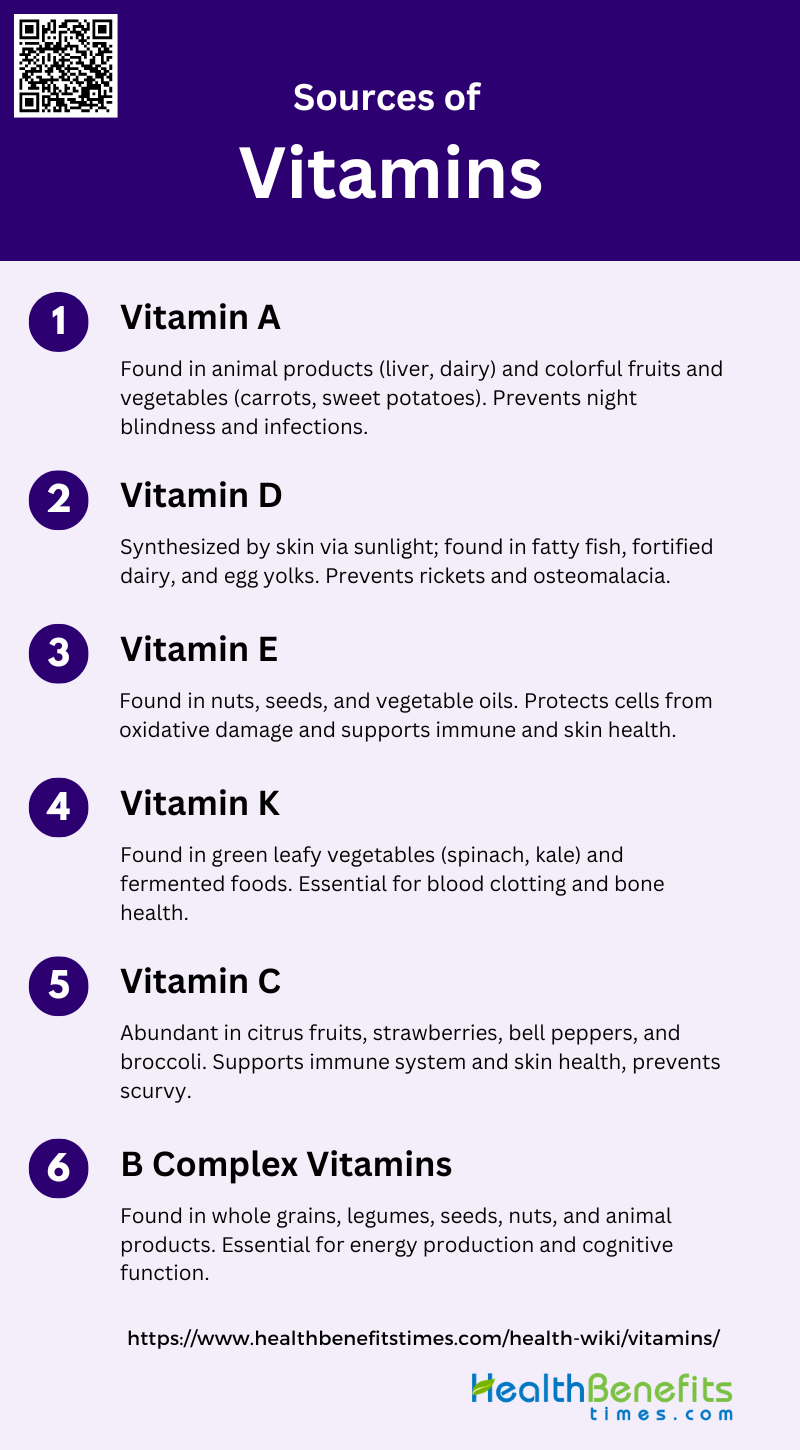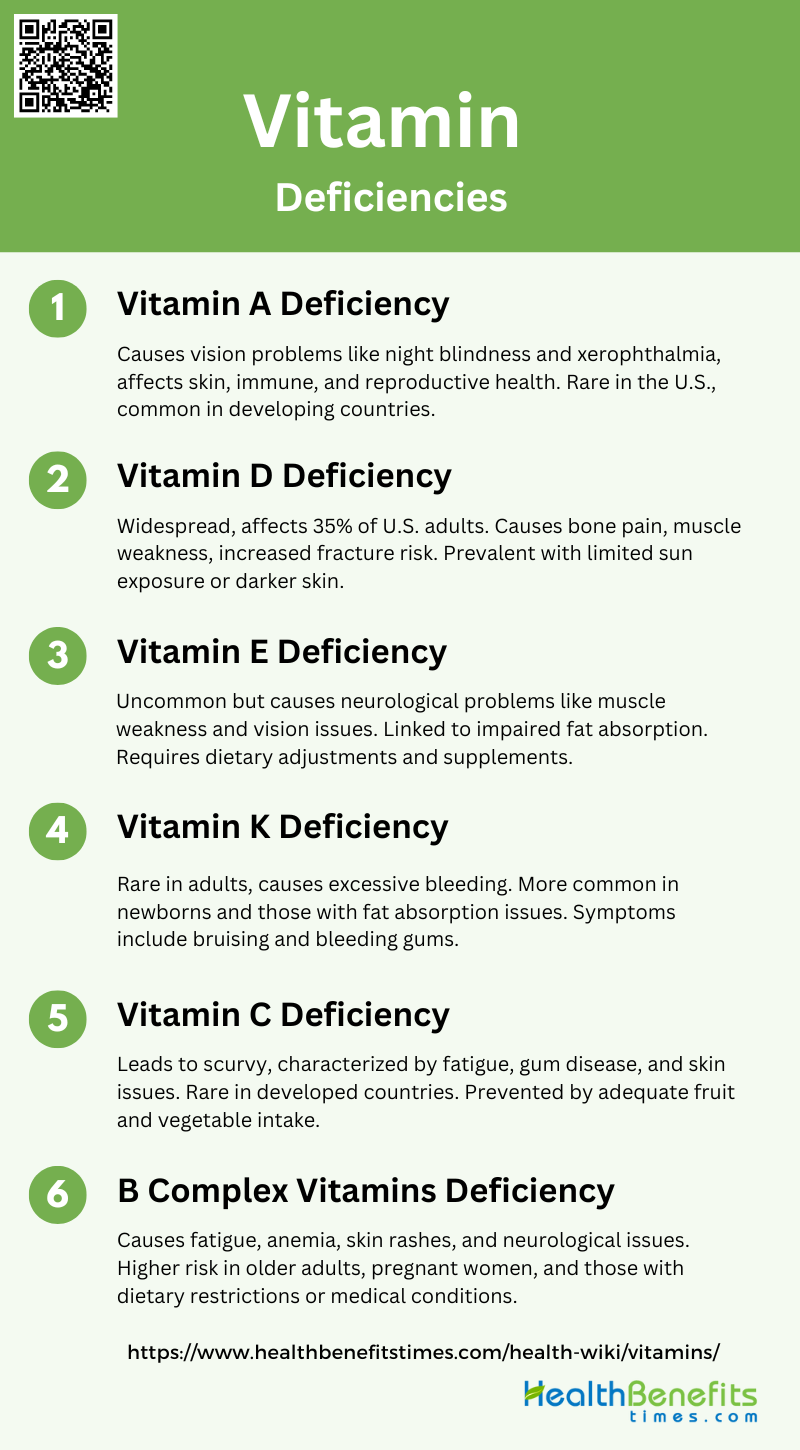Vitamins are essential organic compounds that play crucial roles in maintaining overall health and supporting various bodily functions. These micronutrients, which are required in small amounts, cannot be produced by the human body in sufficient quantities, if at all, and must therefore be obtained through diet or supplementation. Vitamins are classified into two main categories: fat-soluble (A, D, E, and K) and water-soluble (B-complex and C). Each vitamin has specific functions, such as supporting immune function, promoting healthy vision, aiding in energy metabolism, and facilitating proper blood clotting. While a balanced diet typically provides adequate vitamin intake, deficiencies can lead to various health issues, making vitamins vital for optimal physiological processes and overall well-being.
Classification of Vitamins
Vitamins are essential nutrients that the body needs to function correctly. They are classified into two main categories based on their solubility: fat-soluble and water-soluble vitamins. Each category plays unique roles in maintaining health and preventing diseases.
1. Fat-Soluble Vitamins
Fat-soluble vitamins include vitamins A, D, E, and K. These vitamins are absorbed along with dietary fats and can be stored in the body’s fatty tissues and liver for extended periods. They do not need to be consumed daily, as the body can draw upon its reserves when needed. Fat-soluble vitamins play crucial roles in various bodily functions: vitamin A is essential for vision and immune function, vitamin D regulates calcium absorption and bone health, vitamin E acts as an antioxidant, and vitamin K is vital for blood clotting. Because these vitamins can be stored, excessive intake can potentially lead to toxicity, although this is rare with a balanced diet. Good sources of fat-soluble vitamins include fatty fish, egg yolks, liver, and leafy green vegetables.
2. Water-Soluble Vitamins
Water-soluble vitamins comprise the B-complex vitamins (B1, B2, B3, B5, B6, B7, B9, and B12) and vitamin C. Unlike fat-soluble vitamins, these vitamins dissolve in water and are not stored in significant amounts in the body. As a result, they need to be consumed more regularly, ideally daily, to maintain adequate levels. Water-soluble vitamins are crucial for various metabolic processes: B vitamins are essential for energy production, nerve function, and the formation of red blood cells, while vitamin C is vital for immune function, collagen synthesis, and acts as an antioxidant. Excess amounts of water-soluble vitamins are generally excreted in urine, making toxicity less likely compared to fat-soluble vitamins. Good sources of water-soluble vitamins include fruits, vegetables, whole grains, and lean meats.
Functions and Benefits of Each Vitamin
Vitamins play crucial roles in maintaining overall health and supporting various bodily functions. Each vitamin has unique benefits, ranging from boosting the immune system to promoting healthy skin and bones. Below is a detailed list of the functions and benefits of each vitamin:
1. Vitamin A
Vitamin A is crucial for maintaining vision, promoting growth and development, and ensuring the proper functioning of the immune system. It modulates cell-mediated and antibody-mediated responses, contributing to immunoregulation and anti-inflammatory effects. Deficiency in vitamin A can impair innate and adaptive host responses, making supplementation beneficial for enhancing immune responses and combating microbial pathogens.
2. Vitamin D
Vitamin D plays a vital role in calcium homeostasis and bone health. It also has significant effects on the immune system, including the suppression of mycobacterial replication and potential benefits in preventing neurodegenerative diseases. Vitamin D deficiency is widespread and can impair immune function, making adequate intake essential for reducing the risk of infections and supporting overall health.
3. Vitamin E
Vitamin E acts as a potent antioxidant, protecting cell membranes from oxidative damage. It supports immune function by maintaining oxidative balance and has shown promise in managing tuberculosis. Alpha-tocopherol, a form of vitamin E, is actively taken up by the brain, contributing to nervous membrane protection and potentially benefiting cognitive functions.
4. Vitamin K
Vitamin K is essential for blood clotting and bone health. It supports calcium homeostasis and inhibits vessel wall calcification. Vitamin K compounds, particularly menaquinones, are involved in the activation of proteins that support bone mineralization and cardiovascular health. Supplementation may be necessary during anticoagulation therapy to maintain proper vitamin K levels.
5. Vitamin C
Vitamin C is a potent antioxidant and cofactor for biosynthetic and gene regulatory enzymes. It enhances immune defense by supporting epithelial barrier function, promoting phagocytosis, and enhancing the microbial killing activity of neutrophils. Vitamin C deficiency impairs immunity, increasing susceptibility to infections, while supplementation can prevent and treat respiratory and systemic infections.
6. B Complex Vitamins
B complex vitamins, including B1, B6, B9, and B12, play crucial roles in brain function, energy production, and the synthesis of neurotransmitters. They modulate cognitive performance, support brain development, and delay the onset of dementia. Adequate intake of B vitamins is essential for maintaining cognitive functions, especially in the elderly, and for preventing cognitive changes in adolescents with borderline levels of these vitamins.
Sources of Vitamins
Vitamins are obtained from a variety of food sources, each providing different essential nutrients required for optimal health. Understanding where to find these vitamins can help ensure a balanced and nutritious diet. Below is a list of common sources for each vitamin:
1. Vitamin A
Vitamin A is crucial for maintaining healthy vision, immune function, and skin health. It is found in two primary forms: preformed vitamin A (retinol) in animal products like liver and dairy, and provitamin A (beta-carotene) in colorful fruits and vegetables such as carrots and sweet potatoes. Deficiency can lead to night blindness and increased susceptibility to infections.
2. Vitamin D
Vitamin D is essential for calcium absorption and bone health. It can be synthesized by the skin upon exposure to sunlight and is also found in foods like fatty fish, fortified dairy products, and egg yolks. Deficiency in vitamin D can result in rickets in children and osteomalacia in adults, leading to weakened bones.
3. Vitamin E
Vitamin E acts as a powerful antioxidant, protecting cells from oxidative damage. It is found in nuts, seeds, and vegetable oils. This vitamin is crucial for immune function and skin health. Deficiency is rare but can lead to neurological problems due to poor nerve conduction.
4. Vitamin K
Vitamin K is vital for blood clotting and bone health. It is found in green leafy vegetables, such as spinach and kale, and in fermented foods. Deficiency can lead to excessive bleeding and weakened bones. There are two main forms: K1 (phylloquinone) from plants and K2 (menaquinone) from animal products and fermented foods.
5. Vitamin C
Vitamin C is an antioxidant that supports the immune system, skin health, and iron absorption. It is abundant in citrus fruits, strawberries, bell peppers, and broccoli. Deficiency can lead to scurvy, characterized by anemia, gum disease, and skin problems.
6. B Complex Vitamins
B complex vitamins, including B1, B2, B3, B5, B6, B7, B9, and B12, are essential for energy production, cognitive function, and cell metabolism. They are found in whole grains, legumes, seeds, nuts, and animal products. Deficiency can lead to various health issues such as peripheral neuropathy, heart attacks, and strokes.
Vitamin Deficiencies
Vitamin deficiencies occur when the body does not get enough of a specific vitamin, leading to various health issues. Each deficiency can cause distinct symptoms and complications, depending on the vitamin involved. Below is a list of common vitamin deficiencies and their associated effects:
1. Vitamin A Deficiency
Vitamin A deficiency can lead to severe health issues, including vision problems like night blindness and xerophthalmia, which can progress to complete blindness. It also affects the skin, immune system, and reproductive health. In the U.S., it is rare but more common in developing countries due to inadequate dietary intake.
2. Vitamin D Deficiency
Vitamin D deficiency is widespread, affecting about 35% of adults in the U.S. It can cause bone pain, muscle weakness, and increased risk of fractures due to its role in calcium absorption. It is more prevalent in individuals with limited sun exposure, darker skin, or certain medical conditions.
3. Vitamin E Deficiency
Vitamin E deficiency is uncommon but can result in neurological problems such as muscle weakness, coordination difficulties, and vision issues. It is often linked to conditions that impair fat absorption, as vitamin E is fat-soluble. Treatment typically involves dietary adjustments and supplements.
4. Vitamin K Deficiency
Vitamin K deficiency, though rare in adults, can cause excessive bleeding due to its crucial role in blood clotting. It is more common in newborns and individuals with conditions affecting fat absorption. Symptoms include easy bruising, bleeding gums, and blood in urine or stool.
5. Vitamin C Deficiency
Vitamin C deficiency can lead to scurvy, characterized by fatigue, gum disease, and skin issues. It is rare in developed countries but can occur in individuals with poor diets, alcoholism, or certain medical conditions. Adequate intake of fruits and vegetables is essential for prevention.
6. B Complex Vitamins Deficiency
Deficiency in B complex vitamins can cause a range of symptoms depending on the specific vitamin lacking. Common signs include fatigue, anemia, skin rashes, and neurological issues. Groups at higher risk include older adults, pregnant women, and those with certain medical conditions or dietary restrictions.
Overconsumption and Toxicity of Vitamins
While vitamins are essential for health, consuming them in excessive amounts can lead to toxicity and adverse health effects. Each vitamin has a specific upper limit, beyond which it can cause harm to the body. Below is a list of vitamins and the potential toxic effects of their overconsumption:
1. Risks of Excess Intake
Excessive intake of vitamins can lead to a variety of adverse health effects, depending on the dose and duration of consumption. For instance, overconsumption of vitamin A has been linked to hypervitaminosis A, which can cause severe health issues such as xerophthalmia, permanent blindness, and increased mortality rates among children. Similarly, excessive vitamin D intake can result in severe hypercalcemia, hypercalciuria, and nephrocalcinosis, particularly in children and adolescents. The risk of toxicity is heightened by the lack of international consensus on safe upper intake levels (ULs) for various vitamins, which complicates public health guidance.
2. Symptoms of Vitamin Toxicity
The symptoms of vitamin toxicity vary depending on the specific vitamin involved. Vitamin D toxicity, for example, can manifest as confusion, apathy, recurrent vomiting, abdominal pain, polyuria, polydipsia, and dehydration. In the case of vitamin A, acute hypervitaminosis A may present with symptoms such as headache, dizziness, nausea, and even congenital malformations if consumed in high doses during pregnancy. Excessive intake of vitamin B12 has been reported to cause acne, palpitations, anxiety, akathisia, facial ruddiness, headache, and insomnia. These symptoms highlight the importance of adhering to recommended intake levels to avoid adverse health effects.
3. Safe Upper Limits
Safe upper limits (ULs) for vitamin intake are established to minimize the risk of toxicity. For vitamin D, the Institute of Medicine has set the UL at 50 µg (2000 IU) per day, although some studies suggest that higher doses may be safe under certain conditions. For vitamin A, the UL varies but is generally set to prevent hypervitaminosis A, with recommendations to avoid doses exceeding 500,000 IU in adults. The UL for folic acid is suggested to be 1 mg per day in adults to prevent neurological harm, especially in the presence of vitamin B12 deficiency. These ULs are crucial for guiding safe consumption and preventing the adverse effects associated with vitamin overconsumption.
How to Maintain Balanced Vitamin Levels
Maintaining balanced vitamin levels is crucial for overall health and well-being. A varied diet, regular exercise, and mindful supplementation can help achieve this balance. Below is a list of strategies to maintain optimal vitamin levels:
1. Balanced Diet Tips
Maintaining balanced vitamin levels through diet is essential for overall health. A balanced diet rich in fruits, vegetables, legumes, whole grains, and lean proteins can provide the necessary vitamins and minerals. The Mediterranean diet (MD) and the Atlantic diet (AD) are particularly effective, offering essential nutrients such as vitamins D, E, C, A, B-12, and folate, as well as minerals like selenium, zinc, iron, and manganese. These diets emphasize low intake of processed foods and red meat, which helps in reducing oxidative stress and supporting the immune system, especially during viral infections like COVID-19.
2. Importance of Regular Check-ups
Regular check-ups are crucial for maintaining balanced vitamin levels, as they help in early detection of deficiencies and allow for timely intervention. Micronutrient deficiencies can arise from poor dietary intake or physiological issues, and diagnosing these deficiencies often requires comprehensive investigations including dietary, functional, and biochemical assessments. Regular medical check-ups can help monitor vitamin levels and ensure that any deficiencies are addressed promptly, reducing the risk of chronic diseases and improving overall health outcomes. For older adults, regular check-ups are particularly important to monitor and manage micronutrient status, as they are more prone to deficiencies despite consuming fortified diets.
3. Role of Multivitamins and Supplements
Multivitamins and supplements can play a significant role in maintaining balanced vitamin levels, especially when dietary intake is insufficient. For older adults, daily multivitamin supplements have been shown to improve plasma concentrations of essential vitamins such as D, E, B-12, and C, thereby reducing the prevalence of suboptimal vitamin status. However, it is important to note that while multivitamins can help in achieving recommended daily allowances, they should not replace a balanced diet. Excessive intake of certain vitamins through high-dose supplements can pose health risks, making it essential to use supplements judiciously and under medical supervision. For vulnerable populations, such as the elderly and those with specific health conditions, targeted supplementation can be beneficial in enhancing immune function and overall health.
Myths and Facts about Vitamins
Vitamins are essential nutrients that our bodies need to function properly, but there are many misconceptions about them. Understanding the difference between myths and facts can help you make informed decisions about your health. Here are some common myths and facts about vitamins:
1. Vitamin C and Cold Prevention
The role of vitamin C in preventing and treating the common cold has been extensively studied, yet remains controversial. Research indicates that regular high-dose supplementation of vitamin C does not significantly reduce the incidence of colds in the general population. However, there is evidence suggesting a modest reduction in the duration and severity of cold symptoms when vitamin C is taken regularly. Specifically, a reduction of 8% to 9% in symptom days has been observed. Interestingly, individuals exposed to extreme physical stress or cold environments, such as marathon runners and soldiers, may experience a more pronounced benefit from vitamin C supplementation.
2. Multivitamins as a Health Cure-All
The belief that multivitamins can serve as a cure-all for various health issues is widespread but not strongly supported by scientific evidence. While multivitamins can help address specific nutrient deficiencies, their effectiveness in preventing chronic diseases or significantly improving overall health remains questionable. Studies have shown that multivitamins do not consistently reduce the risk of chronic diseases such as cardiovascular disease or cancer. Moreover, the benefits of multivitamins are often modest and may not justify their routine use for disease prevention in a well-nourished population. Therefore, relying solely on multivitamins as a health cure-all is not advisable.
3. Natural vs. Synthetic Vitamins
The debate between natural and synthetic vitamins often centers on their bioavailability and efficacy. Some studies suggest that natural vitamins, derived from whole food sources, may be more easily absorbed and utilized by the body compared to their synthetic counterparts. However, the differences in bioavailability and efficacy are generally small and may not be clinically significant for most people. Both natural and synthetic vitamins can effectively address nutrient deficiencies when taken in appropriate doses. Therefore, the choice between natural and synthetic vitamins should be based on individual preferences, dietary needs, and specific health conditions rather than perceived superiority.





